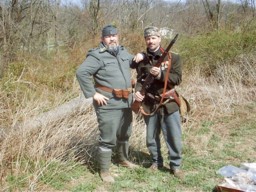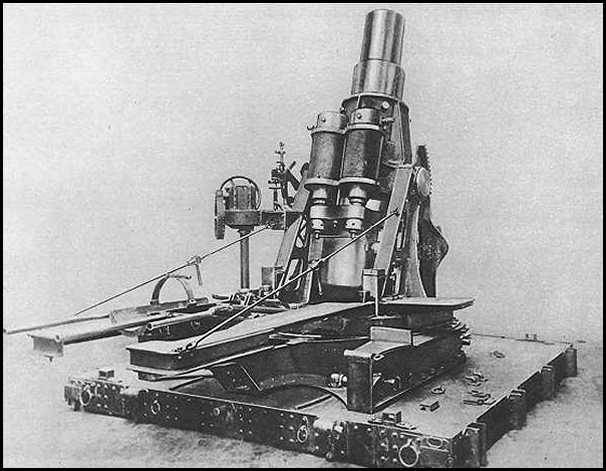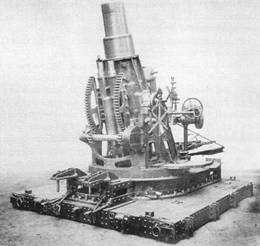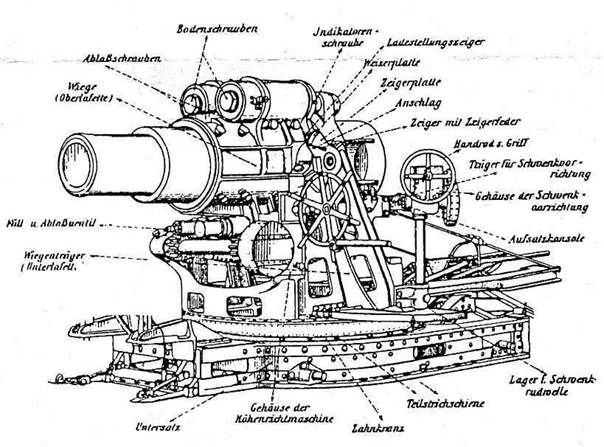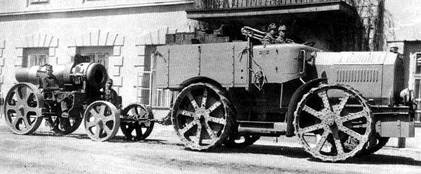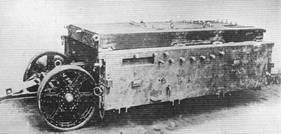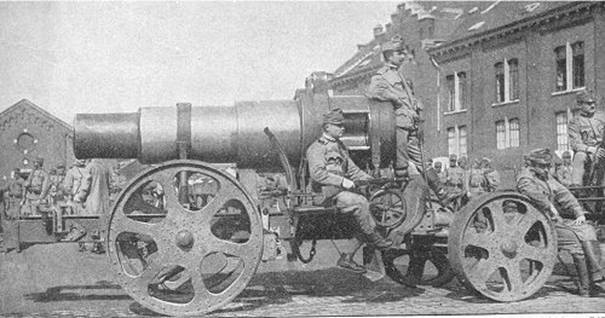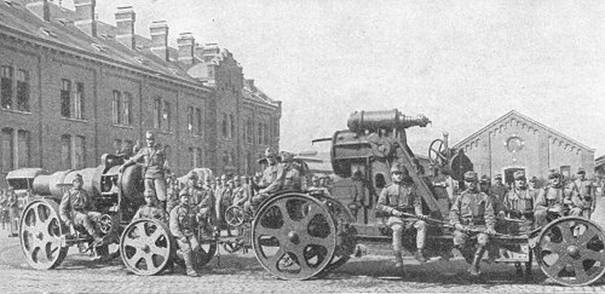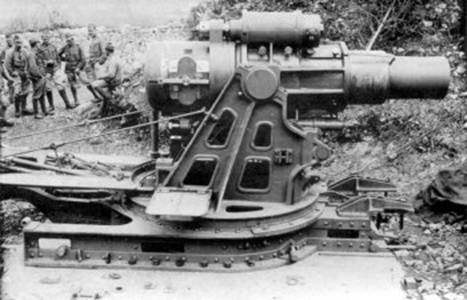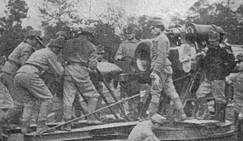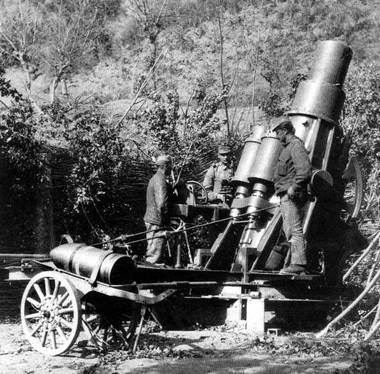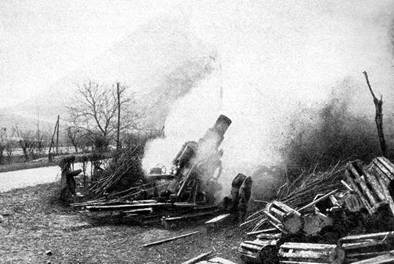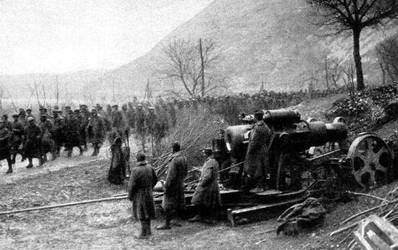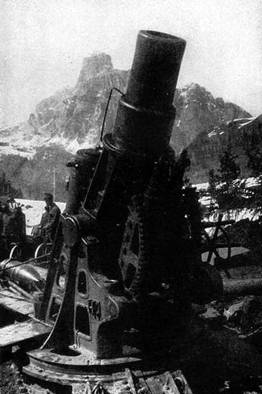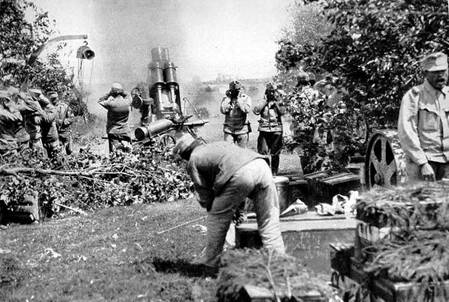|
WW1 Southern
Front Artillery English edition is available cortesy of Jim Haugh-Pennsylvania/USA |
|
Hi
Everyone, Many Thanks to Jim for this edition! The Beginning
In 1885 there were major
advancements in artillery. Heavier and more advanced shells with
calibers over 150 mm made the old rock and stone fortifi Austrian fortifi Each Austrian fortress was
designed to be completely independent. They had large underground
ammunition supplies, food, water and generators to produce electricity.
Troops were specially trained for living long periods of time
underground and in complete darkness. They could even load, aim and fire
weapons in the dark because of a “brail” type touch system of
markings on the guns, shells and detonators. Two major military schools,
Festungsari Trient (an artillery school) and Pioniergenie Trient (a
fortifi On Many shells fell on the small
town of At the start of the Italian/Austrian
war most Austrian units were already fighting on the Russian front. As a
result, the Austrian border with The opening battle started with
40,000 old men and boys against 230,000 regular Italian troops. Wave
after wave of Italian attacks were halted by just a few Austrian
defenders situated on top of the mountains. Italian troops were
especially vulnerable to Austrian machine gun fire and sharp shooters.
yet. A captured Italian officer was found with a document warning him
about the Austrian sharp shooters of the Meraner Standschutzen battalion. After the tragic and completely
avoidable losses Italian commanders decided to try to destroy the
Austrian defenses with heavy artillery. In some months
thousands of shells of all calibers rained down on the Austrian
positions. At the Austrian Fort Lusern communi The new Italian strategy of
raining massive amounts of artillery shells on Austrian positions
created a grave situation. Austrian commanders concluded the solution to
the problem would be using the Top Secret M11. So what’s a
M11??? Only one of the most sophisti Austrians were fanatical about
topography and already had the Italian positions precisely lo The advantage had shifted back to the Austrians………………..
Edited by Jim Haugh-Pennsylvania/USA
|
|
The heavy Austrian mortar 30,5 cm/M11 Before
and during WW1 this gun was one of the most sophisti
Mortar
30,5cm/M11 Development
of this arm started in 1906. The Austro-Hungarian high command ordered a
mortar, able to penetrate and destroy new concrete fortresses built in In
Skoda-Werke
at Pilsen a famous and well equipped arms maker was chosen to develop
the new weapon.
Design
studies of this new mortar finished in 1908 and
in 1909 the first prototype was test fired. Up
to 1911 this weapon was secretly tested
in It
was the beginning of one of the most terrific weapons developed during
WW1.
The
mortar was “State of the Art” being the most modern design currently
produced. With
three major components, it was transported by a special Skoda-Daimler
Road Tractor. The gun could be assembled and ready to fire on only 50
minutes!!. The
solid steel gun tube was attached with two hydra The
gun had very precise adjustments
for angle and elevation combined with an optical target finder. Hydra
All
three parts were transported by a special road-tractor weighing 15 tons,
made by Skoda –Daimler,designated model 12. The tractor wasn’t
capable of high speeds but could transport the parts to high mountain
positions on or off the road.
Road
tractor and gun tube car
Platform car
M11
Two
cars of the gun train From
1912 to 1914 one of these mortars was used to test the resistance of new
Austrian fortifi Tests
on the new armoured concrete roofs were made by hitting them directly
with a shell from the M11 mortar. This testing enabled the
Austro-Hungarian militaries to develop much improved fortifi The
first use of the Mortar was made at the beginning of the war in Together
with heavy German artillery (Krupp 38 cm howitzers) they were used to
destroy Belgian fortresses at German
militaries were very impressed with the mobile M11 mortar. In one day
with his very precise fire destroyed most of Belgian fortifi Karl
Skoda was invited to visit the area and see the results using the new
type M11 shell..
M11
on concrete platform,a precise prepared Position! The mortar was equipped with two types of shells,the “light “one equipped with a normal ground contact detonator and used against infantry positions ,trenches and lightly fortified bunkers and the “heavy” shell with a grossweight of 384 Kg equipped with a timed delay detonator. The heavy shell would penetrate exterior walls and roofs then explode in the inner part of a defence system with horrific results. Most
soldiers of an enemy fort were killed instantly because of a high
pressure wave created by
detonation in the small kasemattes and galleries,the explosion of the
ekrasit load rendered a fortifi At this time, there
was no protection against an central from one of these heavy
shells. Explosion of the “light “
shell would leave a crater of 8 m of diameter, and 8 m deep. Shrapnel
was able to destroy walls made of bricks within 100 m , and all exposed
soldiers would be killed within 400 meters It was a horrific weapon! In 1915 the Austro-Hungarian
army ordered more mortars and by the end of the war they had had more
than 20 Batteries each with 2 Motars 30,5cm/M11. In 1916 an improved version
was developed with more firing range, the 30,5cm/M16. Specifi Caliber:305 mm Elavation: +40 to +70 Degrees Angle :
+ 60 to – 60 Degrees Light weight shell : 287 Kg Heavy weight shell: 384 Kg Velocity of shell :340m/s Firing range with light shell:
11300 m Firing range with heavy shell: 9600 m
Loading the mortar
Ready to fire!
Fire!
Same
mortar!After firing it’s shell, the mortar rotates back automatically
in horizontal position to make reloading easy ,
Italian prisoners of war passing by,a little break for the
gunners!
In
the high Alp mountains , this mortar is on more than 2000m!!
Heavy weight shell firing with maximum powder load. The
pressure wave of this shot is tremendous! Edited
by Jim Haugh/Pennsylvania-USA,Cortesy of Jim Haugh
|
